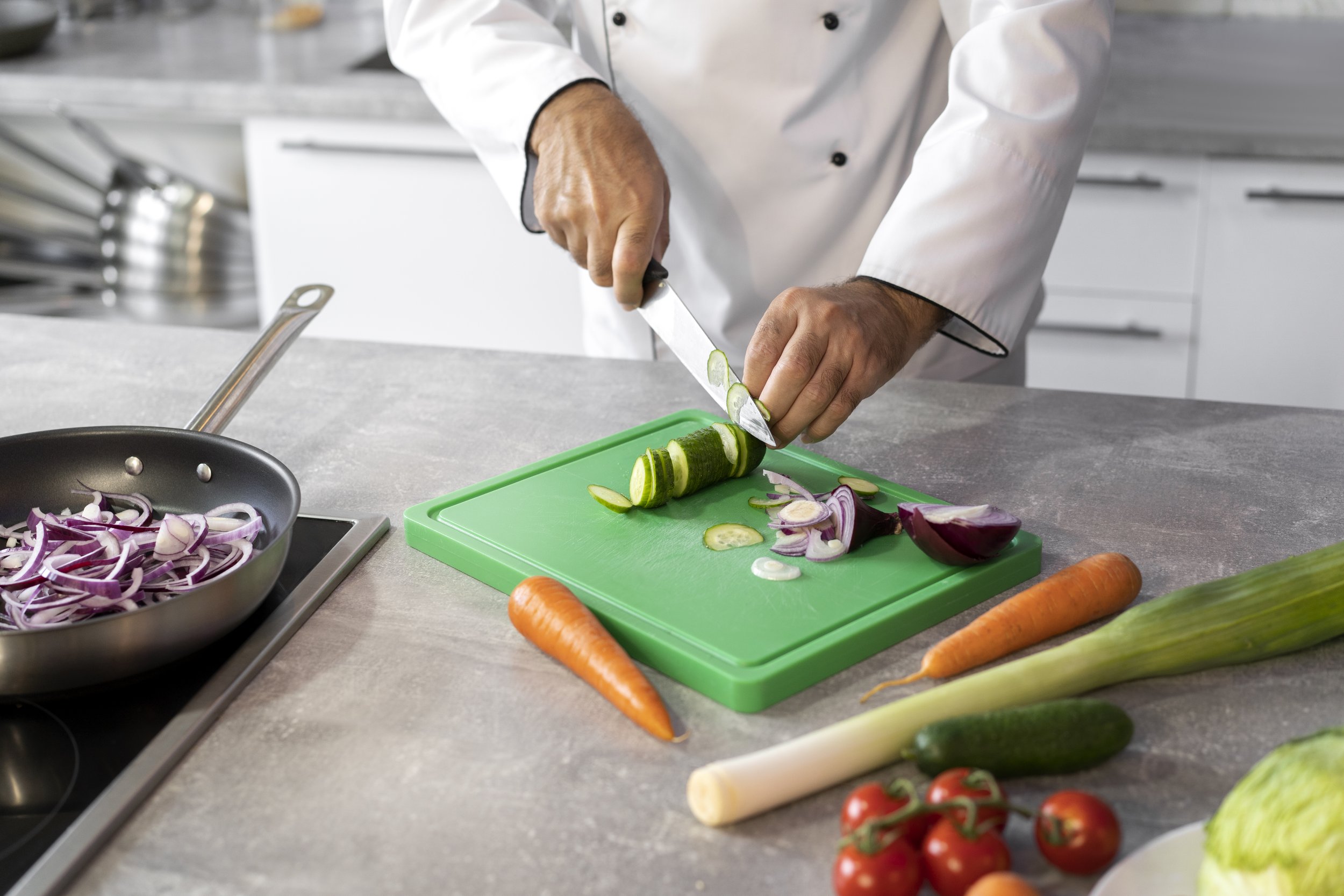5 top tips to get a Level 5 Food Hygiene Rating
The Food Hygiene Rating Scheme explained
The FHRS rating lets customers know the standard of food hygiene in your business so they can decide whether they can eat your food safely. If you have a very good level 5 score it will give customers the reassurance that you are doing things right and may encourage them to choose you over one of your competitors.
Routine inspections are carried out by the Local Authority where your food premises is located, the frequency is dependant on the risk in your business. For example if you are serving vulnerable groups such as patients in a hospital or children’s meals in nurseries, or are doing high risk activities your risk scoring will be higher and you will be inspected more often.
It is a snapshot of food safety in your business and can happen at any time, usually when you are open and trading.
chef cutting up vegetables in a catering kitchen
How is the food hygiene rating made up?
The food hygiene rating score is split into 3 parts:
1) Food hygiene and safety procedures (including food handling practices and procedures, and temperature control)
2) Level of (current) compliance with structural requirements (including cleanliness, layout, condition of structure, lighting, ventilation, facilities etc.)
3) Confidence in management/control procedures
Each section is scored separately but makes up your total score which determines your rating and the frequency of inspections. To achieve a level 5 you must have a score between 0 and 5 in all three sections.
The importance of the confidence in management score
The confidence in management scoring is based on the inspecting officer’s professional opinion and the likelihood of your food business being compliant in the future.
You must make sure that you provide the inspector with enough information so they can make this judgement at the time of the inspection.
What is this opinion is based upon?:
· Evidence of a documented and completed food safety management system based on HACCP principles (see how to get your head around food safety management systems) that is relevant to your business activities and is up to date.
· The track record of your food business in terms of previous poor ratings, complaints etc. and whether you took steps to address these problems as advised by the local authority inspectors (EHO’s).
· Your food safety culture.
· The food safety knowledge of your staff including handwashing, handling of food and temperature control.
· Evidence of comprehensive monitoring and HACCP documentation of food safety risks such as cooking temperatures.
Helen Groves - Environmental Health Practitioner
5 top tips from an EHO
1. During the inspection you or a senior member of your team should accompany the inspector and listen to their advice.
2. Have a copy of your completed and up to date Food Safety Management System (FSMS) on site as either a paper or digital copy. Review it regularly, as a minimum every 12 months or if something changes such as your menu or you start sous vide cooking. (If you are using SFBB check for new published versions on the Food Standard Agency website as these could contain new information or legislation).
3. Make sure you have a specific risk assessment for high-risk foods like vac packed food ,train your staff and keep training records.
4. Make sure your staff are trained or supervised in food safety and allergens and keep this up to date. Check your staff’s knowledge with food safety quizzes, updates and team talks – make food safety and allergens part of your business culture.
5. Complete regular in house manager food safety and allergen audits to help maintain standards. Do audits on different shifts and days and act on anything that isn’t right. As part of the audit check monitoring records are signed off and that any problems are addressed like poor cleaning.
A group of chefs working in a catering kitchen
Are you confident and ready for your next routine food hygiene inspection?
Take our quick quiz to discover actionable insights into your food hygiene practices, food safety documentation and allergen information so you are fully prepared for when the food inspector calls.





